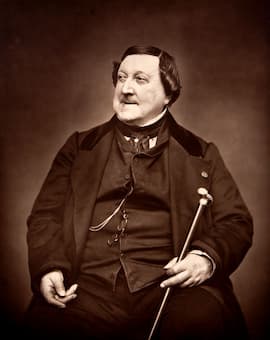
Gioachino Rossini, 1865
Gioachino Rossini’s opera “The Barber of Seville” is one of the most fun operas in the entire repertoire. It’s full of humour and romantic encounters, and for a change, nobody dies. The story is set in Sevilla, Spain during the 18th century. Count Almaviva is rich, powerful, and handsome, and he is obsessed with a young, innocent and pretty girl called Rosina. Rosina is not particularly interested, but the Count tries his luck in a variety of disguises. He tries to seduce her as a soldier, a voice teacher and as a poor student. Rosina lives highly protected with her guardian Doctor Bartolo, and he goes to great length to make sure that Rosina does not meet any eligible bachelors.
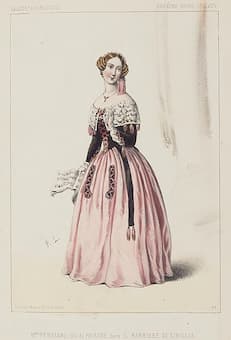
Fanny Persiani as Rosina in Rossini’s
The Barber of Seville
It’s a devious plan, because Rosina will inherit a large amount of money once she turns of age, and Bartolo wants both the girl and her money. Rosina sings “Una Voce Poco Fa” (The voice I just heard… has won my heart) in the first act of the opera. It is one of the most famous and popular selections, and I am sure you know it by heart. Let’s start our medley of best performances with Anna Moffo. Moffo did not have a particularly large voice, but she certainly makes up for this with warm and rich coloring throughout her range. And mind you, her coloratura technique is magnificent.
Rossini: “Una voce poco fa” (Anna Moffo)
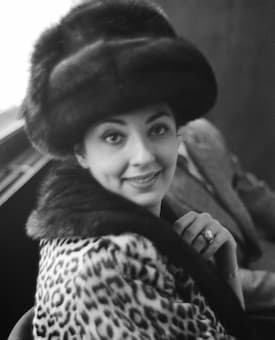
Anna Moffo
The character of Figaro is “The Barber of Seville.” He is a crafty character and he knows all the gossip in town. Since his customers are telling him all their secrets he is well informed, and he is constantly scheming to take advantage of his knowledge. Count Almaviva, having had no luck in his pursuit of Rosina so far, asks Figaro for help in his courtship. In the opposing camp, the corrupt priest and music teacher Basilio, who senses that something might be going on between Rosina and her suitor, supports Dr. Bartolo. Alarmed, Bartolo rushes in to marry Rosina, but Figaro intervenes and somehow manages to officially marry Rosina to Count Almaviva. One of the most popular arias in this opera belongs to Rosina. She has just heard a voice serenading her; the voice of Count Almaviva disguised as the student Lindoro. In “Una voce poco fa” (she anticipates that he will be hers, and then proclaims that, if anyone interferes, she knows 100 tricks to get her way.”
Rossini: “Una voce poco fa” (Maria Callas)
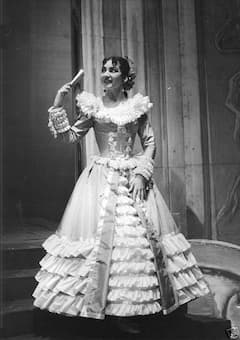
Maria Callas as Rosina, 1956
In the original play written by Beaumarchais, Rosina is described as the “prettiest, daintiest girl, sweet, tender, courteous and fresh, whetting the appetite, furtive foot, well-turned waist, plump arms, rosy lips, and what hands, what cheeks, what teeth, what eyes!” Maria Callas certainly is not a young girl in this particular performance, but it is fascinating to hear the precision and ease with which she navigates the deviously difficult leaps, scales, trills and ornamentations. Callas bring her delicious variety of tonal colors to the role, as it needs to align with the many moods portrayed in the aria. There is initial innocence, then amusement, determination, anger, and eventually triumph. Rossini had strong opinion about the ideal vocal production for his characters. “All voices,” he writes, should follow the example set by the castrati since the intrinsic beauty of sound and the impeccable execution of agility passages are elements essential to an expressive rendering.” Callas once commented on this aria by saying, “Believe me, you will make a better effect with good feeling in your voice than with the hullabaloo of a lot of notes.”
Rossini: “Una voce poco fa” (Isabel Leonard)
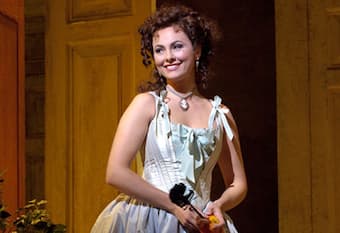
Isabel Leonard as Rosina
Surprisingly, Rossini chose the role of Rosina for a contralto instead of, as is typical for the heroine, a soprano. Rossini believed that “the contralto voice, for which ability, agility and brilliance are not excluded, was more suitable to portray the character of Rosina from the danger of becoming the conventional figure of a young, disrespectful and malicious young woman.” Rossini’s choice essentially suggests that despite her young age, Rosina is a mature and aware woman. Grammy Award winning Isabel Leonard is not a contralto but a mezzo-soprano, but she brings passionate intensity, remarkable vocal beauty and a huge voice to the role. Leonard makes for a feisty and supremely confident Rosina. There is just enough comic timing for listeners to understand that the “force of Rosina’s sly shyness combines with devilish determination to outwit her guardian.”
Rossini: “Una voce poco fa” (Teresa Berganza)
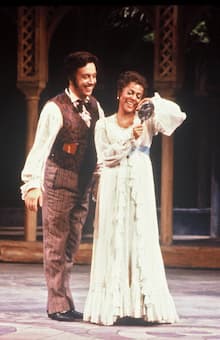
Kathleen Battle
We know that Rossini enjoyed large, warm, and “resonant voices with a fluidity that enabled his coloratura passages to be sung in full voice.” Apparently, he detested forced, hard sounds and phlegmatic mezzo voce coloratura passages. And he certainly hated when performers saturated the aria with additional ornamentations. Adelina Patti was known for her florid rendition of “Una voce poco,” and Rossini is reported to have asked her, “Very nice, my dear, and who wrote the piece you have just performed?”

Teresa Berganza, 1957
Of course, this showcase aria does leave room for singers to include their own ornaments. From my reading of the literature it seems that Rossini might have considered the Spanish mezzo-soprano Teresa Berganza best suited for this role, which is sung with confidence and precision and just the right amount of ornamentation. And while we should also mention the great Marilyn Horne, my vote for best performance of “Una voce poco fa” goes to Kathleen Battle. The silvery purity of her sound and tone is paired with distinctive colouring throughout her range. This allows her to beautifully portray Rosina’s cunning shyness, and still explode in shivering ecstasy in the coloratura. Now you know my favourite performances, which one is yours?
For more of the best in classical music, sign up to our E-Newsletter
Rossini: “Una voce poco fa” (Kathleen Battle)




Probably not the best recording of Callas in this aria. The ones with Galliera and Serafin are so much better. For me, Callas owns this aria. Her vocal virtuosity combined with her expressiveness leaves everyone else for dead
I wish you put Marilyn Horne in this list as well. She sung Una Voce Poco Fa so beautifully. I’m in LOVE with that tone.